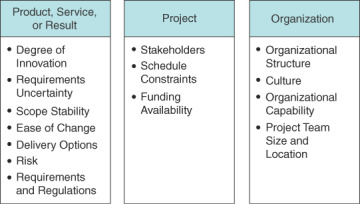- "Do I Know This Already?" Quiz
- Fundamentals of the Project Life Cycle
- Project Life Cycle vs. Product Life Cycle
- Development Approach and Life Cycle Performance Domain Concepts
- Life Cycles in Practice
- Considerations for Selecting a Development Approach
- Project Activity, Deliverables, and Milestones
- Summary
- Exam Preparation Tasks
- Review All Key Topics
- Define Key Terms
- Suggested Reading and Resources
Considerations for Selecting a Development Approach
Several factors influence the selection of a development approach. The PMBOK® Guide – Seventh Edition, Section 2.3.4 outlines these factors, as shown in Figure 4-13. The criteria can be divided into three categories: product, service, or result; project; and organization. It is important to review the meanings of each of these components.

Figure 4-13 Considerations for Selecting a Development Approach
Product, Service, or Result
The factors influencing the product, service, or result consideration all have to do with the nature of a project’s outcome, whether it is a product, a service, or another type of result.
Degree of Innovation
Deliverables that have a well-understood scope and requirements, that the project team has worked with before, and that allow for planning up front are well suited to the predictive approach. Deliverables involving a high degree of innovation or those with which the project team does not have experience are better suited to a more adaptive approach.
Requirements Certainty
A predictive approach works well when the requirements are well known and easy to define. When requirements are uncertain, volatile, or complex and are expected to evolve throughout the project, a more adaptive approach is a better fit.
Scope Stability
If the scope of the deliverable is stable and not likely to change, a predictive approach is practical. If the scope is expected to undergo many changes, an approach that is closer to the spectrum’s adaptive side can be helpful.
Ease of Change
Related to requirements certainty and scope stability, if the nature of the deliverable makes it challenging to manage and incorporate changes, then a predictive approach is best. Deliverables that can quickly adapt to change can use an adaptive approach.
Delivery Options and Cadence
The nature of the deliverable, such as whether it can be delivered in components, influences the development approach. Products, services, or results that can be developed and delivered in pieces are aligned with incremental, iterative, or adaptive approaches.
Risk
You can reduce risk by building products modularly and adapting the design and development based on learning to take advantage of emerging opportunities or reduce the exposure to threats. Adaptive approaches frequently mitigate high-risk requirements by addressing their viability first.
Safety Requirements and Regulations
Products that have rigorous safety requirements often use a predictive approach because significant up-front planning is needed to ensure that all the safety requirements are identified, planned for, created, integrated, and tested. Likewise, environments that are subject to significant regulatory oversight may need a predictive approach due to the required process, documentation, and demonstration needs.
Project
The factors in the project consideration column all have to do with aspects of the project, such as how it is structured, constrained, and funded.
Stakeholders
Specific stakeholders, such as product owners, play a substantial role in establishing requirements from the customer’s perspective and prioritizing work. If such dedicated project team staff are available to support project work, adaptive methods are preferred.
Schedule Constraints
If there is a need to deliver something early, even if it is not a finished product, an adaptive approach is beneficial.
Funding Availability
Projects that work in an environment of funding uncertainty can benefit from an adaptive approach. A minimum viable product can be released with less investment than an elaborate product. This allows for market testing or market capture with minimum investment.
Organization
The factors in the organization consideration column all have to do with the organizational environment of the project, including the culture, structure, and complexity.
Organizational Structure
An organizational structure with many levels, a rigid reporting structure, and substantial bureaucracy is likely to use a predictive approach. In contrast, projects that use adaptive techniques are associated with a flat structure.
Culture
A predictive approach fits better in an organization with a culture of managing and directing. Here the work is planned out and progress is measured against baselines. Adaptive approaches fit better within an organization that emphasizes project team self-management.
Organizational Capability
If organizational policies embrace attitudes and beliefs that support an agile mindset, then adaptive methods are likely to succeed.
Project Team Size and Location
Adaptive approaches often work best with project teams of five to nine individuals. Adaptive approaches also favor project teams that are located in the same physical space.
